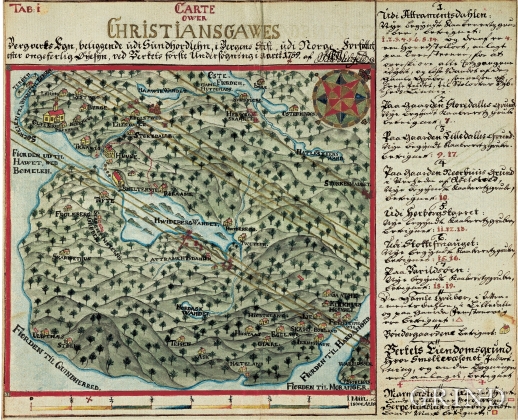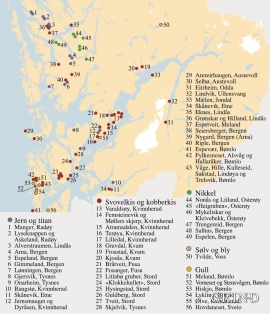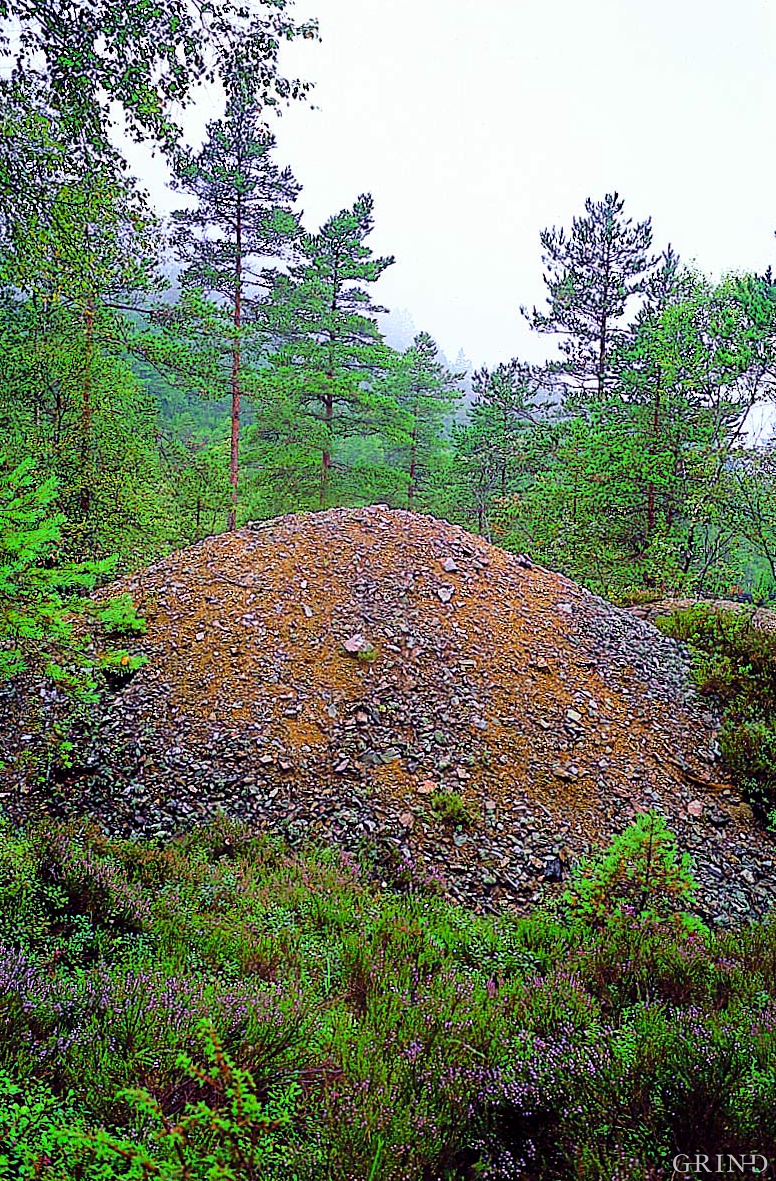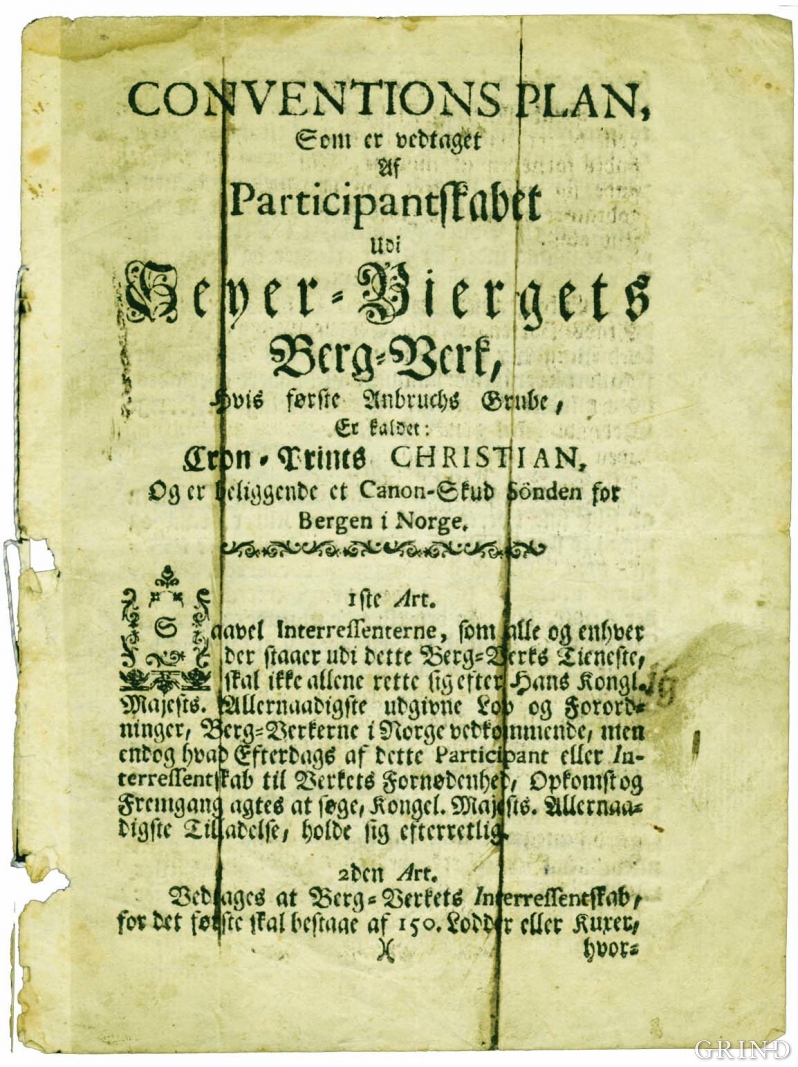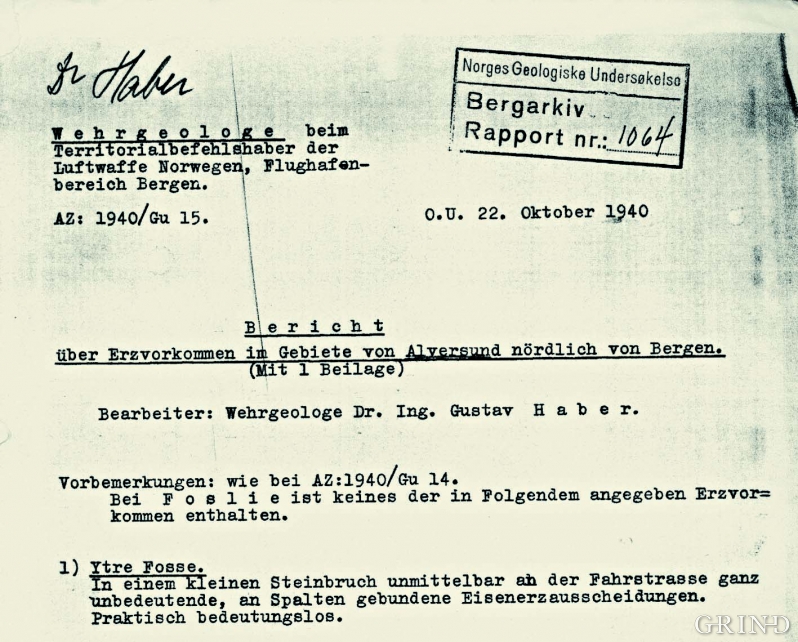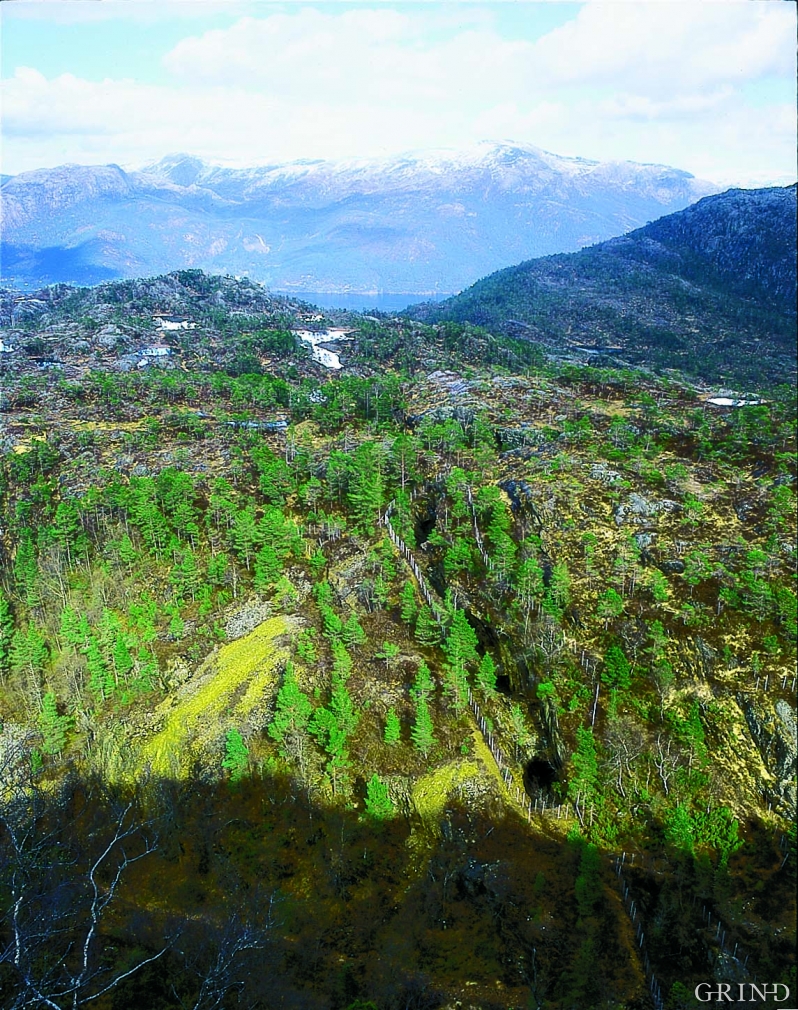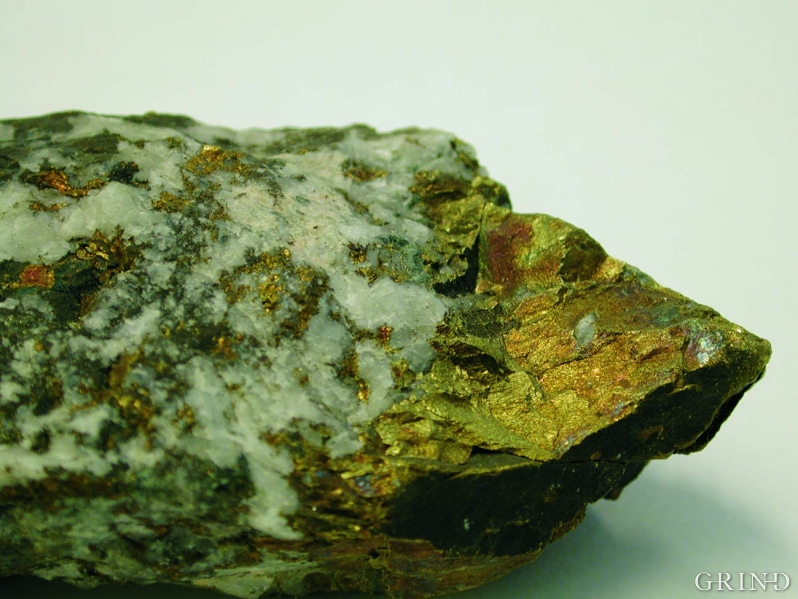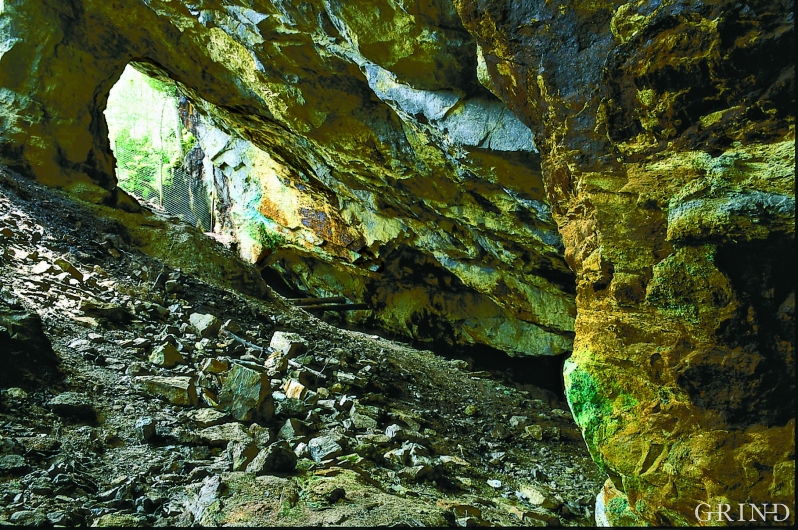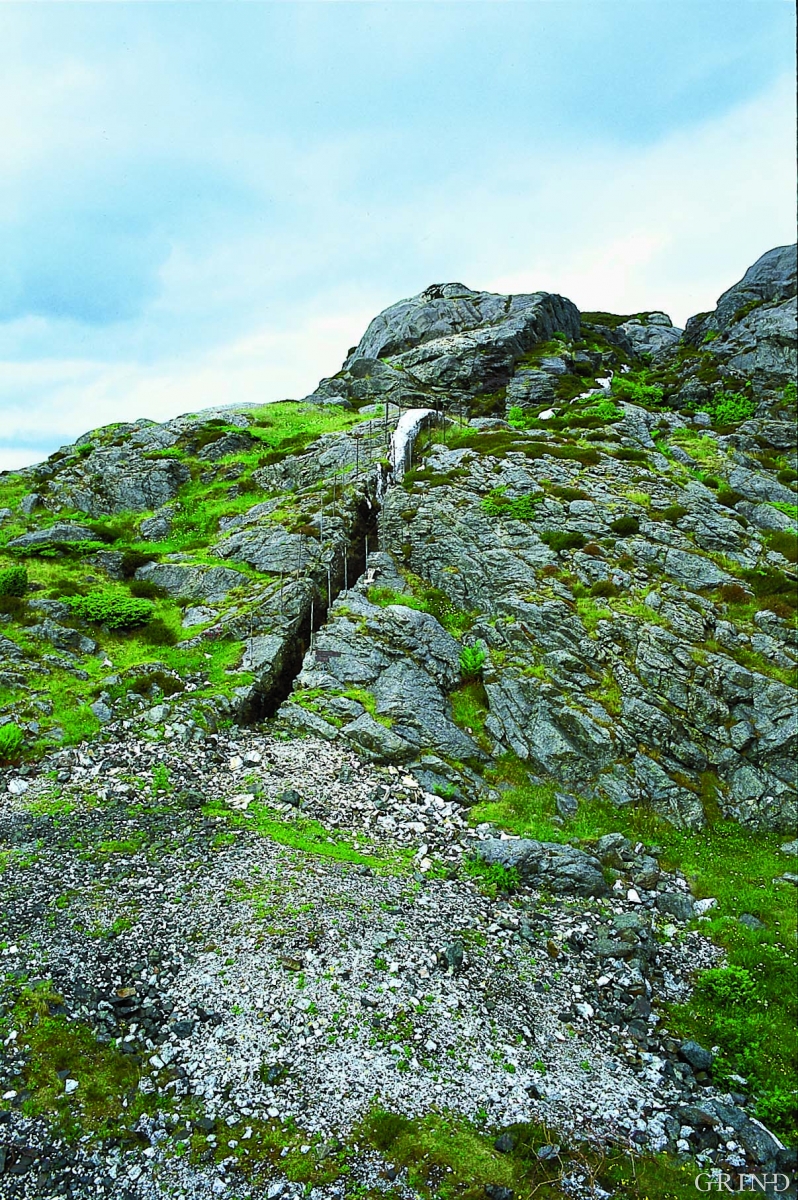Published: 28.10.2004 | Author: Øystein J. Jansen
Kart over Christiansgaves Bergverk med omgivelser, tegnet av H.F. Blichfeld i 1759.
Ølve has the oldest known mines in Hordaland. In 1642, privilege was granted by the king to build an iron works in Jernsmuget on the property of Lilledals Farm, and five years later a copper works on the same property. Operations were suspended in 1673. Mining resumed again in the municipality in the 1750s. Also this time, in the region of Ølve.
Another century was to pass before mining became a significant business sector in Hordaland - and then the ore was pyrite. For the most part the ore veins were too sparse; they were quickly depleted or prices were too low. Over the course of the 1900s there were steadily fewer people working in the mines. The last mine in the municipality, Stordø Kisgruber, closed down in 1968.
Pioneer age
The oldest documents describing any specific Norwegian mine is a deed issued by King Hans in 1490, giving permission to operate a copper mine in Sandsvær in Numedal. There was probably mining activity earlier than this, but written sources are very uncertain.
In his book of 1771, H. F. Blichfeld, who operated several mines in the Ølve district of Kvinnherad in the 1700s, writes that there was a copper works here in olden times, possibly closed down around 1350 after the Black Death. As the basis for this presumption he points to an old legend in the district and evidence of slag piles and mounds of stone wastage left behind by the mining activity. Later authors have little confidence in Blichfield's story, however, and reject it as "highly unlikely".
In the middle of the 1600s there was a surge in copper mining in Norway. Røros kobberverk (Røros Copper Mine) was opened in 1644. It was copper that was the mainstay of the mining activity in the Ølve area (*p. F252). Iron production in Jernsmauet is hardly mentioned in the reports. The newly established copper works operated for the most part in Atramadalen, by Lake Kvitebergvannet, but under the name Lilledals Works. Reports tell of periodic profits, but mostly of a problematic enterprise with periods when the mining activity ceased altogether. The privilege was given to "Dearest man and servant Henrik Thott (feudal overlord at Bergenhus) and some of his participants, citizens in our trading town Bergen." The participants were quite wealthy inhabitants of the city. They each owned their own share, just like shareowners in a ship in later times. The local farm-owners were required to contribute wood from their forests, transport, etc. The farmers were probably happy when the privileged city dwellers had to close down Lilledals Works after a generation of supplying compulsory materials and services.
Operating methods
In the olden days, ore was hacked and hammered out with simple hand tools. Later, a method of loosening by heating the rock was used, in which bedrock is warmed up by open fire until it breaks up and thereby makes the ore easier to remove. This method required a lot of wood and could result in deforestation around the mines. Early in the 1600s, a technique involving extraction by hand drilling and exploding with black powder was developed in Europe. It is thought that the first use of this method in Norway was in the Lilledal copper mine in 1655. One reason to think this is found in the following comment in a report from 1655 from this mine: "Due to the lack of fire-setting wood the mine cannot be sufficiently fuelled. The farmers' lack of good will is to be blamed".
Both methods, of loosening the rock by heating with fire, and drilling and exploding with black power, continued to be used for many years since this was economically profitable. "Firing wood" is consistently mentioned in the financial statements of the Hordaland mines. Fire-setting in Norwegian mines was not phased out until dynamite and hand drills made of hard steel were obtained around 1870.
The well known speculator from Bergen, Commerce Director Jørgen Thormøhlen, bought Lilledals Works in 1686, probably without starting operations. New mining activity was established at the end of the 1750s - also this time in the Ølve region.
Operations in 1759 - 1785: the Blichfeld Period
The controversial mining merchant Henrich Franzen Blichfield took an interest in the copper deposits in the old mining area. After a couple of years and new investigations he invited investors to become shareholders in 1759. Also this time, the shareholders were gentry and merchants from Bergen. The copper deposits at Atramadal and Lilledal were mined, in addition to a deposit at Gravdal in Kvam. The smelting ovens were finished in 1765, so that the ore could be smelted on site.
The Blichfeld Period seems to have been one endless conflict between the share holders, who had little faith in Blichfield and his seemingly incessant need for new investments, which were based on all too optimistic evaluations. In 1772 a new shareholder constellation was formed, which included "both His Majesty and the royal gentry". As thanks for this encouragement Blichfield decided that the mining works would be called "Christiansgaves bergverk" (= Christians gift Mine), and the individual mines and drift mines received a myriad of new names, primarily from the royal family and royal court. The mine was closed down probably around 1775, upon Blichfield's death. It seemed as if the profits had been meagre. In "News of Qvinherreds pgd." from 1820, H. P. Herzberg makes the following bold assertion: The mine workers were trash from Røros and several other mines, whom they there were glad to get rid of, since they were drunkards and incompetent.The shareholders were deceived of their money.”
Seyerbiergets Mining Operation
In 1761 the Ølve mines were supplemented with a new mine at the foot of Seiersberget mountain, by Lake Store Lungegårdsvann in Bergen. According to its "Convention Plan", the first mine was called "Crown Prince CHRISTIAN" and its locale was given as "lying a cannon-shot's distance south of Bergen in Norway".The ore that was mined was chalcopyrite and the leading shareholder was Jørgen Blytt.
The rediscovery of this mine can be followed in Bergen's history in several phases. The Bergen historian Lyder Sagen reported enthusiastically around 1840 in "Urda" that he had found a rare document: Seyerbiergets Bergverks Conventionsplan. (= Seyerbiergets Mine's Convention Plan). Operations resumed in 1845 - possibly as a result of Sagen's discovery - but were quickly terminated. And the mine was forgotten again. The entryway got covered by earth before it was re-discovered in 1909 by railway workers carrying out mining activity in connection with alterations of the railway lines. They contacted the newspaper "Labour" which sent a journalist to the mine, "Who was accompanied by two railway workers who with great courteousness gave up their breakfast and their entire rest period to make themselves available to the curious journalist". The following day one of the city's learned men, School Headmaster Bendixen, told of Sagen's discovery - and the day after the newspaper told of a lesser discovery of a shareholder certificate in the mine from the 1700s in the Krohn's family papers. The last contact with the mine was when Madam Felle drilled through Fløyen mountain at the end of the 1980s - but this time it did not make the newspapers.
1700s mining operations in Hardanger
There are existing documents which suggest that Jørgen Blytt also journeyed to other places. Chalcopyrite (copper pyrite) was found on the Eitrheim and Langsæter Farms at Sørfjorden, and Blytt and two others drew up a shareholder prospectus in 1762. None of the localities met up to expectations, and they seemed only to have a very limited test period. One mine at Mælen in Jondal belonged to the Christiansgave works in the 1700s, and there were possibly several other smaller mines of the same type. It is said that the ore from Langesæter was transported to the Christiansgave works for smelting. The same probably applies for all of the other mines - also Seiersberget's.
The Century of Pyrite
Pyrite (containing both iron and sulphur) makes up by far most of the volume in the copper ore deposits in Norway. The deposits were, however, only used for copper production. Pyrite was either not taken out, or was considered useless and thrown away. Sulphur at that time was delivered from Sicily, where it occurred in a pure form. When prices rose dramatically around 1830, sulphur was in demand in Europe's growing chemical industry. Then, pyrite began to be used as a raw material for sulphuric acid production.
In Norway pyrite production began in the late 1850s, and around 1900 it was essentially the most important product from Norwegian mining operations. The pyrite was mainly delivered as "export pyrite" - that is, exported to producers of sulphuric acid outside Norway.
Demand for pyrite grew sharply also in our district, and since the 1860s many new deposits have been discovered, big and small. This attracted also foreign investment. Geologist Th. Hiortdahl summarizes the situation in the following way in 1877: "A right lively mining activity has arisen around Bergen, where the previously active nickel mines are in Englanders' hands, at the many deposits around Hardanger Fjord, mainly copper-depleted masses of pyrite, which are the most abundant of them, where Valaheiens mine (på Varaldsø) is built; of the large number of deposits otherwise, many of them are insignificant, and also can have had more or less short term operation."
Pyrite Distrikt Ølve – Varaldsøy
In 1851 the mining inspector reported on claims in Christiansgaves works old mines. The first mine started operations in 1857 at the Bergen firm Brandt Co with 40 men, mainly in Atramadalen. Mostly pyrite, but also some chalcopyrite was taken out. The Bergen firm closed after a time, but several other interests started up in this "pyrite district". Lysaker Chemical Plant started in 1861, and eventually operated several mines for its own sulphuric acid production.
Several pyrite deposits were discovered on Varaldsøy, the largest in 1866 by English interests, and Valaheien svovelkisgruver mine was established (*p. R251). Toward the end of the 1880s pyrite prices sank and operations were terminated in the whole area. During the years before and during the First World War some pyrite was produced in this region. At Gravdal, operation of the old pyrite mine was resumed during the Second World War. Operations continued also after the war. The mine was taken over by Stordø Kisgruper in 1954.
Stordø Kisgruber - not first, but biggest
The pyrite mines in the area of Litlabø in Stord (*KHV p. R211) were without comparison the largest mining operation in our municipality. Operations started in 1865, and with a varying workforce (72 men at the most, in 1866) was led by Norwegian interests. Several deposits in the Litlabø area remained unutilized. The pyrite was a very dilute "water pyrite", but the large size of the deposits and lack of contamination by other metals made it nonetheless useful - even though operations sometimes incurred a loss. In 1907 the mines fell into Belgian hands. Some years later they were taken over by a German concern. After the war the Norwegian government overtook, and Stordø Kisgruper Inc. became a Norwegian company under the Department of Industry. Operations were closed in 1968, but much of the mine was preserved in the Mining Museum in Litlabø (*p. R221).
Isolated attempts to mine pyrite in Hardanger and Sunnhordland
In the 1860s the demand for pyrite led to the opening of a number of smaller mines. Common to all of them was that they all closed after a short time, most often, after only a few years.
Two mines were established on the Folgefonna Peninsula in 1866, Lindvik in Ullensvang and Mælen in Jondal. Lindvik was operated by Norwegian interests in the beginning, with as many as 23 men. The mine was taken over by a German company in 1873, who made large investments in tram railways and buildings. After a short time the company went bankrupt. The installation lies right above the main road on the west side of Sørfjorden, and one can still see brick walls and other remains from the mining operations. Mælen kisgruber operated with 4 - 5 men for some years around 1866, and then started new operations for some years around the turn of the century with 10 - 15 men. The latter period of operation started with 20 men around 1916, when the mines were taken over by Norske Svovelgruber Inc. The depression years in the 1920s caused bankruptcy in 1925.
In Kvam, on the other side of Hardangerfjord, there was experimental operation around 1850 at Froastad. New experimental operation was initiated in two periods between 1903 - 1909, the latter time by a German company. Selvågen gruve mine at Tysnes was in operation for about 3 years in the 1880s, by Det Bergenske Gruveselskab (= Bergen Mining Company). Also here there was some experimental operation in 1909 by a German company. Otherwise, there have been some isolated attempts at Eitrheim in Odda (1875) and Kjøsås in Kvam (1884).
In the police official’s report for Bømlo from 1856 - 60, nothing is mentioned about prospecting. But in the report of 1866 there is talk of considerable prospecting for pyrite in Steinsvåg, Sakseid, Hille, Lindøy and Espevær . At the end of the 1860s most of the prospecting holes and mines were closed - there was mining activity only at Lindøy and Espevær in 1866-70. Operations increased again for a period in the 1870s, first and foremost at Lindøy.
Copper Mines in the late 1800s and early 1900s
During the "pyrite period" there were a number of mines that were taking out chalcopyrite (which contains copper). None of them were very large, most were operating for only a short period - and none of them had smelting works. The pyrite was sent to other works for smelting.
The largest of these mines seems to have been Tveit gruver at Huglo (*p. R283) which started in the late 1860s. Operations were suspended in 1885. In Sunnhordland we also find Guldberg Kobbergruve (= Guldberg copper mine) near Leirvik. After its establishment in 1865 this mine had a successful, but short period of operation - it was closed in 1869. Later experimental operations did not give results at any of these mines. Alvsvåg gruver at Bømlo was established in the 1860s, but the main operations took place in 1882-84. It was then in the hands of Vigsnes gruver on Karmøy, and the pyrite was sent to the smelt works there. The mine was described as “Substantial, given our conditions ", by geologist Reusch after an inspection in 1888.
In the Bergen region, the first copper mines of this period were Espetveit gruver at Holsenøy and Grønskaret gruve at Radøy. Both were started by Norwegian interests in 1880, but in 1881 were taken over by the English company Norway Copper Mines Company. They started enthusiastically with 80 men employed, many of them from Cornwall in England. Already in April the following year they closed down, and the shares of 200,000 Norwegian crowns was "in the most insipid way ", used up.
There are reports of prospecting and experimental mining in 1888 at Riple in Fana. These operations continued sporadically until 1910. The operations were made possible by Bergen capital, except for one round of experimental mining in 1905 " sponsored by an American capitalist ".
In 1906 a French company started operations at Nygård in Arna. 110,000 Francs were spent on large-scale operations until it was closed in March, 1908. The longest vein is said to have been 180 m. All of these deposits consisted of quite meagre chalcopyrite veins; "the conditions seemed very little promising " was a usual comment from the mining inspector. In addition to these mines, there was some smaller scale prospecting on several deposits in Nordhordland.
Iron mines
Several shiploads of magnetite were exported to England in the 1860s from the previously discussed deposits in Jernsmauet in Ølve. Later, there were only a few sporadic attempts up until the First World War. At Baugstø on the north side of Åkrafjorden there is a relatively large deposit of titanium-bearing iron ore at several mines and prospecting pits along an area of 1 km2. The mine was in operation from 1871 - 1875, but the results, according to verbal sources, were limited to export of a couple of shiploads of ore to England. In 1911 there was experimental mining of magnetite at Gimmeland jerngruve in Fana, and afterwards irregular mining until 1918. New investigations were undertaken in 1938 - 39 and latest in 1941 by a geologist from the occupation forces, Wehrgeologe Dr. Ing. Gustav Haber – but mining was not started. Otherwise, there are a number of smaller prospecting pits for titanium-bearing iron ore several places in Lindås, Radøy and Arna. Dr. Ing. G. Haber concluded that these, also, were too meagre, after his inspection in 1940.
Nickel mines
Nickel-bearing ore was first discovered in Norway in 1837. From around 1850, there was a great interest in nickel as an alloy metal for nickel silver and coin production. Many mines were started, and in 1870 Norway was one of the world's largest producers of nickel.
Production at Nonås in Litland in Hosanger (*p. R423) was started in 1882 by a Bergen company, but was soon taken over by Varaldsø Mining Company , who sent the experienced mining engineer Alexander Barratt to Osterøy. He was a Methodist and known for imposing a strict and Christian discipline in his workplace. He had "transformed many a wildman " at Varaldsøy, it said in the local history book. During its first years there were up to 60 men employed in the mines. The number was reduced to about 20 up until 1890 - when the company went bankrupt - as was the case with most of the other Norwegian nickel mines.
The reason for the bankruptcies was strong competition from Canada. Toward the end of the 1800s, interest increased again for nickel and steel production, among other things for steel armour. Prices rose steadily, and in the years between 1910 - 1915 several of the Norwegian nickel mines re-opened. After a few short periods of operation following the bankruptcy of 1890, Kristiansand Nikkelraffineringsverk took over the mining operations at Osterøy in 1914. The company made large investments, but went bankrupt in 1920 - at the same time as the mine was ready for operation. Kristiansandselskapet Raffineringsverket A/S resumed operations with a new name and new money in 1933. Up until its closure in 1945 this was the next largest of the Norwegian nickel mines.
Demand for nickel led also to experimental operation at a small deposit on Espelid Farm in Åsane. After a limited operation in the 1860s, new attempts were made in 1918 with 5-6 men employed. But mining was discontinued the next year and all that was left was an open pit in the terrain.
Tvildegruva Mine at Voss
In the 1880s, two Englishmen operated a lead deposit containing a little bit of silver near Tvildmoen at Voss. There must have been earlier attempts to mine here, since a wooden bucket dated to 1760 was found in the mine - but we do not know more about these earlier operations. A little experimental mining was undertaken around 1900, and the last time from 1917 and a little later. There are also a couple of smaller prospecting pits for silver in Landegalen (around 1870) and Skaftedalen in the same district.
Gold at Bømlo
The first discovery of gold at Lykling in Bømlo (*p. R268) is associated with a story about a Shepard boy who found a gold, soft stone in 1862, which he hammered flat and used to repair a crack in his wooden shoe. Mining did not start until 1883, however, when The Oscar Gold Mining Company Ltd. bought privileges from a Norwegian company that had found gold in a copper prospecting pit. "Gold fever" spread, and Lykling was invaded by fortune hunters as several more companies got established in the area. After two or three years, most had had enough, but the refinanced "New Oscar Gold Company Ltd." continued its operations until 1898 - with grand promises to its shareholders, but with meagre yields. A new attempt from England in the years 1906 - 1910 yielded 2 kilograms of gold - and that was the end of the gold fever.
A modest industry
Even though iron, copper, nickel, lead, pyrite, chalcopyrite, silver and gold have been mined for several hundred years in Hordaland, one cannot say that the municipality has yielded a fortune in the form of expensive ores. The bedrock is not expected to support any appreciable mining industry in the future, either. The geology is simply not on our side in this respect. We can, however, be comfort by the fact that conditions are favourable in another way on Hordaland's outer edges: On the shelf to the west of Hordaland, with roughly a 60-year history, a real "gold mine" is to be found - even if the "gold" is black and flowing.
- Carstens, H. (red.). 2000. Bygger i berge. En beretning om norsk bergverksdrift.
- Foslie, S. 1955. Kisdistriktet Varaldsøy-Ølve i Hardanger og bergverkdriftens historie. Norges Geologiske Undersøkelse nr. 147.
- Reusch, H. 1888. Bømmeløen og Karmøen med omgivelser geologisk beskrevne.
- Stautland, B. 2000. Gullgravarane på Lykling. Bømlo kommune, Kulturog miljøvernseksjonen.
- Steinsvåg, S. 1965. Gruvedrift på Bømlo. Sunnhordland årbok 46.
- Vatle, L. 1988. Gruvedrift på Osterøy. Osterøy Skolestyre.

